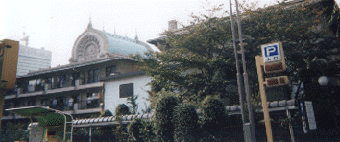Miyoshibashi:
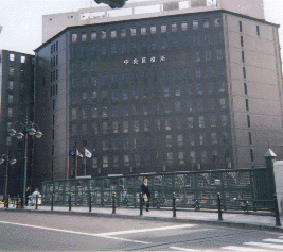
三吉橋北側たもとから中央区役所を見る
|
The four turned right onto Showa Dori at the junction of one and two chome in Higashi Ginza. Between the buildings only street lamps shone,like water falling in clear regimented lines. The shadows of buildings in the narrow streets crowded out the moonlight.
Soon the first bridge that the four had to cross loomed tall infront of them, the bridge, built over the river where it broke into three tri butaries, was of an unusual 'Y' shaped design. On the corner on the other bank , the gloomy Chuo ward office sat squat, the hands on it's clockface backlit by the glowing face pointed to a curious time.The bridge's handrail was low and on each of the three arms of the 'Y' elegant lilly shaped lamps stood.
|
The third bridge was Tsukiji bashi, and although the tastelessness of the city centre was no exception in the area around the bridge, a willow tree had been planted on the foot of the bridge. Passing by on a routine basis, you'd be forgiven for not noticing this forlorn willow; even still, it stood alive and defiant, surrounded by concrete on a sliver of land,it's leaves stirring in the river wind.
{Note:There is no willow tree at the foot of Tsukijibashi. Kanako dropped out at this bridge.}
|
Tsukijibashi:
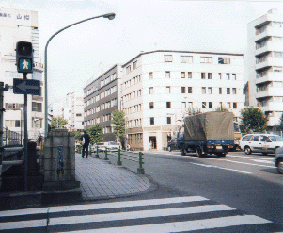
築地橋都電通り新富町桜橋方面を見る
|
Irifunabashi:
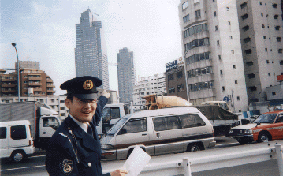
散歩者を呼び止めたお巡りさん 聖路加病院は?の質問にポーズをとってくれました
|
The three crossed the fourth bridge,Irifunabashi, in the opposite direction to the previous Tsukijibashi and gathered at it's foot,all praying in a similar fashion. Masako felt sorry for Kanako but unlike normal feelings of sorrow, they were muted. The selfish feeling that welled up inside her was that those who dropped out made their own choice to follow a different route from the one that lay ahead. Each person's wish was their own business, and in this situation there was no way she could help.This was different to helping somebody carry a heavy pack up the mountain, this was each to his own.
|
Although it was dark, Irifunabashi's name itself could just be made out, written lengthways in white characters on a green or black metal plaque on a stone support at the foot of the bridge. The bright uniform lights of the Caltex petrol station threw out shadows onto the wide expanse of concrete around it, seeming to make the far side of the bridge float upwards into the light.
|
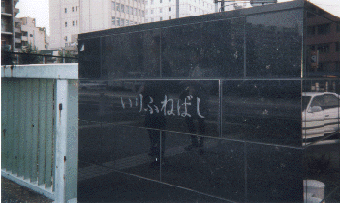
{The present day Irifunabashi name plate is made of granite not metal.}
|
St. Luke's Hospital:
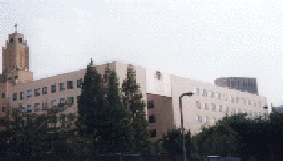
|
After the river flowed under Irifunabashi, it curved round almost in a right-angle. It was a little far until the fifth bridge, Akatsukibashi. A wide deserted road that followed the river had to be walked to get to Akastukibashi. Before too long on the left bank of the river, the grand building of St Luke's Hospital came into view.
|
Then the lurid white supports of the fith bridge Akatsukibashi appeared,strangely shaped pillars daubed with white paint.(Omit).Crossing the bridge they found themselves infront of St Luke's hospital car park.
{Note: It's at this bridge that Koyumi drops out}
|
Akatsukibashi:
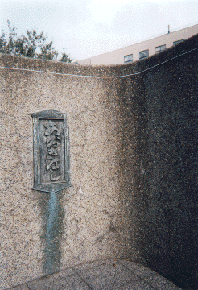
{The bronze bridge nameplate,streaked from being exposed to the rain. St Luke's hospital can be made out in the background}
|
Sakaibashi:
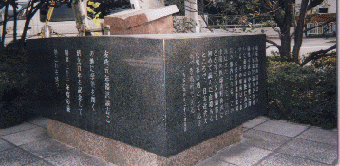
{Note: Sakaibashi couldn't be found, and according to a map from the middle of the Showa
era it was shown to be in the vicinity of the original site of Keio University.}
|
Then the sixth bridge, Sakaibashi was right infront; all it was was a small bridge
constructed from green painted steel plates.
|
'Bizenbashi' was inscribed on a concrete support similar in shape to a shamisen case. Attached to the top of the same pillar was a sorry looking lamp. Looking over to the left bank of the river the blue domed roof of Honganji could be seen rising into the night sky.
|
Bizenbashi:

|
<{The Bizenbashi nameplate is so overgrown with bushes that it can't be seen.}BR>







